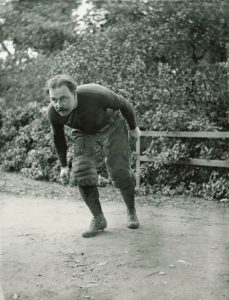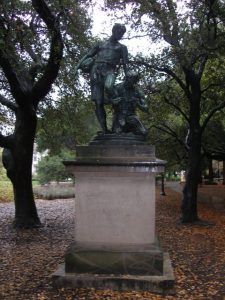
The 31 October edition of NEGHS’s Weekly Genealogist ran a quiz asking readers whether they had any ancestors who participated in organized sports as adults. It reminded me that this past Thanksgiving marks one hundred and twenty years since my great-grandfather first played in “The Big Game” between the University of California (Berkeley was its only campus at the time) and Stanford – this year’s game will be played tomorrow.
Fred Athearn played a variety of sports at Pomona College, and when he transferred to the University of California he was urged by both students and faculty to be part of their football team. Cal had never beaten Stanford, but they’d just hired a new coach from “Back East,” and hoped that this – plus new blood among the players – would yield better results. The stakes of this rivalry were now higher than ever, since U.S. Senator James D. Phalen had just offered to place a statue on the campus of whichever university won two successive games. Until that happened, the statue would remain on display in Golden Gate Park.
As my great-grandfather described it in his memoirs[1] year later, the rules of the game were very different then. “The ball could be passed backward and laterally but not forward, so there were only line plunges, end runs, and punts. There were no 15-minute quarters. The game was divided into two 35-minute halves, with a ten-minute rest period. If a man was taken out of the game for any reason, he could not return.”

Imagine Cal’s excitement when the final score was 22 to 0 over Stanford! Players ended up with bruises all over their backs … not from game injuries, but from all the “love pats” administered by fans, as players were hoisted onto students’ shoulders and paraded around the field after the game. This triumph was exceeded only by Cal’s victory over Stanford the following Thanksgiving, 30 to 0. Shortly thereafter, Senator Phelan had Douglas Tilden’s statue moved to the University of California campus and mounted on a base carved with the names of each year’s players (many of whom played both years).
My great-grandfather finished describing this time in his life with the simple statement, “That ended my career as a football player.” However, through the online California Digital Newspaper Collection, I’ve been able to track down much more information, plus pictures of the team. Thirty-five years later the Oakland Tribune[2] ran a front-page story about the university’s “Dream Team,” complete with a photo from 1899.
The article included these wonderful details: “A new coach from Princeton, Garry Cochrane, and the three mustaches were credited with the double victory after years of gridiron defeat for the Golden Bears. The players were superstitious about the mustaches and refused to permit their possessors to shave them off during the two seasons.”
[My] sons had christened their great-great-grandfather “Mustache” after I bought a picture of him on eBay, all decked out in his Cal uniform.
I was tickled when I read this, since my sons had christened their great-great-grandfather “Mustache” after I bought a picture of him on eBay, all decked out in his Cal uniform. Incidentally, online auctions and retailers can be great places to find images of your long-ago family members, assuming the photos have the good fortune to be labeled. After discovering that a Civil War-era picture of Fred Athearn’s uncle had been purchased on eBay and donated to the Nantucket Historical Association, I did a search for “Athearn photo” and hit the jackpot. I also found an old picture postcard featuring the orphanage in Watsonville, California, where Fred spent several months as a boy. All good fodder for family historians!
Notes
[1] Fred Goodrich Athearn, “A Story of a California Boy,” unpublished manuscript, 1957.
[2] Oakland Tribune, 24 March 1934, 1.
Love this Pamela, so much information in two sources proving what you already knew from family stories? The sentence that struck me though is the “several months in…..the Orphanage as a boy.” My Dad did the same in Spokane, WA. I have a pretty large file trying to find something about where in Spokane. Only proof is the story from himself and a Post Card to an older sister from an older brother about his being “at school in Spokane.” after their Mother died in 1911″ when he was about 4 yrs old. He was there also with a brother who was about age 6 at the time. Fortunately they rebelled (Dad’s word from being homesick) and their Father brought them home to the Metalines in Pend Oreille Co.
The American football rules seem in 1899 to have been the same as in English Rugby Union football. Were there 3 points for a try, 2 for a conversion, etc?
Good question. Here is what I got from my great-grandfather’s writing, as well as from Wikipedia.
From FG Athearn: “The game played was American football (rugby did not appear until some years later).” This statement was confusing to me, but I found an answer that I’ll share in a bit. He went on with a few more particulars about the game in those days. “In the season of 1898, one of the line plays we used was the flying wedge. The guards would hold on to the center’s belt. The tackles would line up somewhat farther back of the line of scrimmage and hold on to the guards’ belts; the ends line up behind the tackles holding their belts, and the half backs held onto the ends’ belts. The quarterback would cary the ball in the middle of the V-shaped formation and the whole group would move forward. This particular play was quite brutal and was soon abolished.”
Now some stuff from Wikipedia:
“The Big Game between Stanford and California is the oldest college football rivalry in the West. The first game was played on San Francisco’s Haight Street Grounds on March 19, 1892 with Stanford winning 14–10. The term “Big Game” was first used in 1900, when it was played on Thanksgiving Day in San Francisco. During that game, a large group of men and boys, who were observing from the roof of the nearby S.F. and Pacific Glass Works, fell into the fiery interior of the building when the roof collapsed, resulting in 13 dead and 78 injured.[112][113][114][115][116] On December 4, 1900, the last victim of the disaster (Fred Lilly) died, bringing the death toll to 22; and, to this day, the “Thanksgiving Day Disaster” remains the deadliest accident to kill spectators at a U.S. sporting event.[117]”
This next part is fun because my brother, a half-sister, and I all attended the University of Oregon. The Ducks (or the Webfeet, as they were then called), played against our great-grandfather! “The University of Oregon began playing American football in 1894 and played its first game on March 24, 1894, defeating Albany College 44–3 under head coach Cal Young… In 1899, the Oregon football team left the state for the first time, playing the California Golden Bears in Berkeley, California.[118]”
Now to find an answer for my great-grandfather’s curious “rugby did not appear until some years later” statement (again from Wikipedia): “In 1906, citing concerns about the violence in American Football, universities on the West Coast, led by California and Stanford, replaced the sport with rugby union.[176] At the time, the future of American football was very much in doubt and these schools believed that rugby union would eventually be adopted nationwide.[176] Other schools followed suit and also made the switch included Nevada, St. Mary’s, Santa Clara, and USC (in 1911).[176] However, due to the perception that West Coast football was inferior to the game played on the East Coast anyway, East Coast and Midwest teams shrugged off the loss of the teams and continued playing American football.[176] With no nationwide movement, the available pool of rugby teams to play remained small.[176] The schools scheduled games against local club teams and reached out to rugby union powers in Australia, New Zealand, and especially, due to its proximity, Canada. The annual Big Game between Stanford and California continued as rugby, with the winner invited by the British Columbia Rugby Union to a tournament in Vancouver over the Christmas holidays, with the winner of that tournament receiving the Cooper Keith Trophy.[176][177][178]”
Cal returned to American football in 1915 and Stanford in 1918. There is a great chart on Wikipedia which shows the various scoring conventions throughout the history of American football. According to it, from 1898 to 1903 points were scored as follows: Touchdown 5, Field Goal 5, Conversion (kicking) 1, Safety 2. Probably more detail than you were looking for, but there you have it!